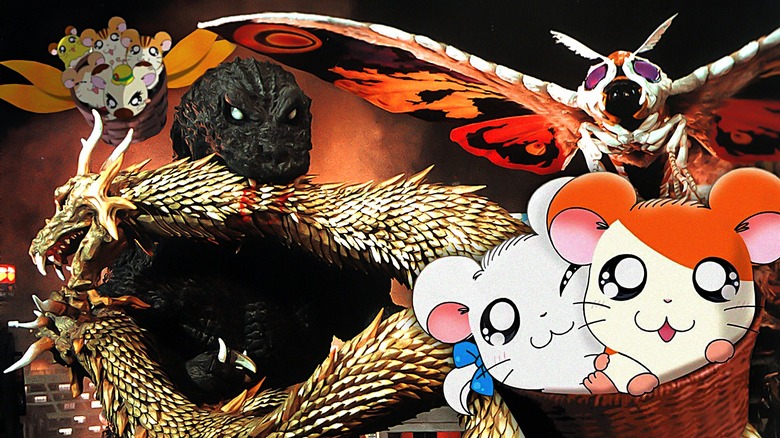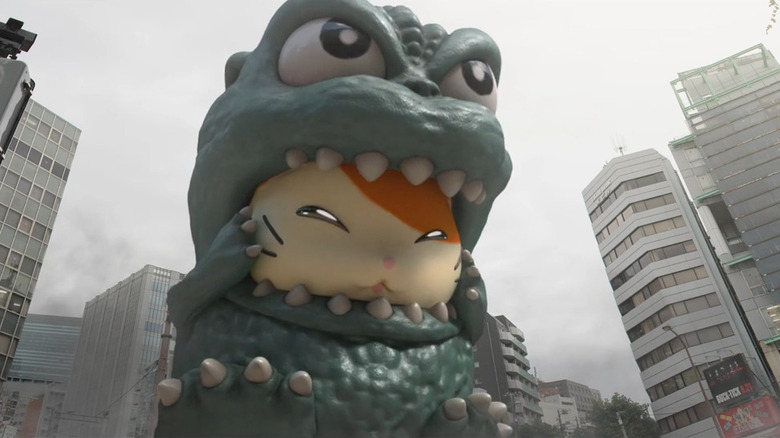Japan's Most Bizarre Crossover Highlights Barbenheimer's Biggest Missed Opportunity
Barbenheimer was an unprecedented cultural event. Born from two vastly different movies marketed at different audiences, with zero things in common other than a release date and the fact that they had big budgets, "Barbie" and "Oppenheimer" somehow inspired a totally organic, fan-driven "crossover." Granted, it was never really a proper crossover, and neither film's marketing campaigns acknowledged the other's, but fans didn't care. As much as the cultural conversation was aware, Barbenheimer was real, and it made both "Barbie" and "Oppenheimer" hugely successful at the box office.
Indeed, the fan-made double feature caught on, and soon enough thousands of people were planning to watch both halves of Barbenheimer back-to-back on release day, embracing each film as part of a whole rather than play into box office competition. But years before people coined the term Barbenheimer, and even years before another brilliant piece of counter programming made both "The Dark Knight" and "Mamma Mia!" box office successes, there were two vastly different Japanese franchises that had their own Barbenheimer moment. I'm talking about Hamtaro and Godzilla. Yes, the anime about adorable hamsters (known as Ham-Hams) doing cute hamster things, based on the manga and storybook series created by Ritsuko Kawai, and the iconic kaiju franchise about a giant lizard monster that terrorizes Tokyo. The two films had their own Barbenheimer moment, only their "crossover" event actually merged both franchises through an official double bill and merch to boot.
Back in December 15, 2001, Japanese audiences witnessed the release of two extremely different films arguably meant for very different audiences. On the one hand was "Godzilla, Mothra, and King Ghidorah: Giant Monsters All-Out Attack," the 26th film in the "Godzilla" franchise, and on the other was "Hamtaro: Adventures in Ham-Ham Land," a feature film spin-off of the "Hamtaro" anime following the titular hamster trying to find a magical seed to be able to talk to his owner Laura.
Godziham destroys Tokyo through the power of brand collaborations
Toho, the studio that Godzilla built, distributed both films, and decided to pair them up as a double feature. That's right, unassuming young kids hoping to see their favorite animated hamster going on an adventure could stay in their seats to see Godzilla wreck Tokyo while fighting Mothra and King Ghidorah, while their little brains melt away. Not just that, but to market the double feature, Toho also created the character "Godziham-kun," which is essentially just Hamtaro dressed in a Godzilla costume (see above), and distributed Godziham-kun figures to filmgoers. The crossover, of course, proved to a be a huge success, and "Giant Monsters All-Out Attack" is considered to be the film that saved the "Godzilla" franchise after a string of flops.
The crossover continued the next two years, with "Godzilla Against Mechagodzilla" and "Hamtaro: The Captive Princess" getting their own double bill, and later with "Godzilla: Tokyo S.O.S" and "Hamtaro: Ham Ham Grand Prix." These came with their own assortment of additional figures, which had hamsters in Mothra larva costumes and Mechagodzilla costumes. Except it went deeper, too, with "Godzilla Against Mechagodzilla" including an Easter egg in the shape of a girl that looked identical to Hamtaro's owner carrying a hamster cage in a scene. The Godziham line was revived in 2021 for the 20th anniversary of the original double bill, and today you can walk unassumingly into an official Godzilla store in Japan and — next to merch for the Oscar-winning "Godzilla Minus One" — witness the truly bizarre sight of official Godziham plushies, keychains, magnets, shirts, and more.
Barbenheimer may have dominated social media for a few months, but we truly missed out on official merch like Nuclear Scientist Barbie with a porkpie hat (or a plushie of Oppenheimer dressed all in pink).

